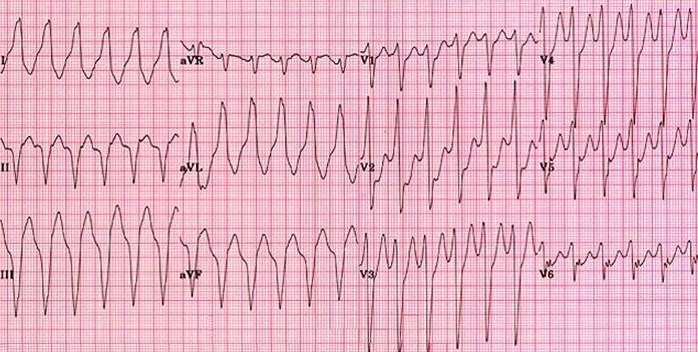Makindo Medical Notes"One small step for man, one large step for Makindo" |
|
|---|---|
| Download all this content in the Apps now Android App and Apple iPhone/Pad App | |
| MEDICAL DISCLAIMER: The contents are under continuing development and improvements and despite all efforts may contain errors of omission or fact. This is not to be used for the assessment, diagnosis, or management of patients. It should not be regarded as medical advice by healthcare workers or laypeople. It is for educational purposes only. Please adhere to your local protocols. Use the BNF for drug information. If you are unwell please seek urgent healthcare advice. If you do not accept this then please do not use the website. Makindo Ltd. |
Broad Complex Tachycardia
-
| About | Anaesthetics and Critical Care | Anatomy | Biochemistry | Cardiology | Clinical Cases | CompSci | Crib | Dermatology | Differentials | Drugs | ENT | Electrocardiogram | Embryology | Emergency Medicine | Endocrinology | Ethics | Foundation Doctors | Gastroenterology | General Information | General Practice | Genetics | Geriatric Medicine | Guidelines | Haematology | Hepatology | Immunology | Infectious Diseases | Infographic | Investigations | Lists | Microbiology | Miscellaneous | Nephrology | Neuroanatomy | Neurology | Nutrition | OSCE | Obstetrics Gynaecology | Oncology | Ophthalmology | Oral Medicine and Dentistry | Paediatrics | Palliative | Pathology | Pharmacology | Physiology | Procedures | Psychiatry | Radiology | Respiratory | Resuscitation | Rheumatology | Statistics and Research | Stroke | Surgery | Toxicology | Trauma and Orthopaedics | Twitter | Urology
Related Subjects: |Classical Ventricular Tachycardia |Idiopathic Ventricular Tachycardia |Ventricular Fibrillation |Resuscitation - Adult Tachycardia Algorithm |Resuscitation - Advanced Life Support |Atrial Flutter |Atrial Fibrillation |Wolff-Parkinson White syndrome (WPW) |Supraventricular Tachycardia (SVT)
⚡ Key Rule: Any regular broad complex tachycardia = treat as VT until proven otherwise. >95% of adults with structural heart disease + BCT have VT.
📖 About
- Broad complex QRS: >120 ms (>3 small squares).
- Ventricular Tachycardia (VT): Wide complex tachycardia >120 bpm, usually regular.
- Always treat as potentially peri-arrest.
📊 Classification by Regularity
- Regular BCT:
- Ventricular Tachycardia (commonest)
- SVT with aberrant conduction (bundle branch block)
- Idioventricular rhythm (post-MI, <120 bpm)
- Atrial flutter with fixed aberrancy
- SVT/flutter with WPW
- Irregular BCT:
- Atrial fibrillation with aberrant conduction
- Pre-excited AF (WPW) – irregular + delta waves
- Torsades de pointes (polymorphic VT, prolonged QT)
🩺 Clinical Features
- Chest pain, syncope, hypotension, cardiogenic shock → unstable.
- Variable S1 intensity → AV dissociation.
- Past IHD/structural disease strongly favours VT.

 VT
VT
🔎 Investigations
- 12-lead ECG if stable.
- Bloods: FBC, U&E, Mg, Troponin.
- Echocardiogram → LV function, structural disease.
📉 ECG Features that Favour VT
- Capture beats – normal narrow complex amid VT.
- Fusion beats – hybrid QRS from atrial + ventricular activation.
- AV dissociation – P waves march through at own rate.
- No RS complexes in chest leads.
- Very broad QRS (>140 ms, esp. with BBB morphology).
- Extreme axis deviation.
- Concordance (all QRS complexes same polarity in V1–V6).
- Deep S in V6, tall monophasic R in V1.
- No response to adenosine (though may unmask flutter).
💡 Mnemonic: “Very Bad A Cardiac Thing” for VT on ECG: Very Broad QRS • Bizarre morphology • AV dissociation • Capture/fusion beats • Torsades clues
⚕️ Management (Resus Council UK)
- Unstable (shock, chest pain, syncope, hypotension, pulmonary oedema): Immediate DC cardioversion (synchronised shock).
- Stable: 12-lead ECG, call cardiology. Antiarrhythmics: IV amiodarone (300 mg over 20–60 min, then infusion). Avoid AV-nodal blockers in WPW.
- Adenosine: May terminate SVT with aberrancy or some idiopathic VTs. ⚠️ Do NOT use in pre-excited AF (can precipitate VF).
🌟 Summary: Regular broad complex tachycardia = VT until proven otherwise. Check for AV dissociation, capture/fusion beats, extreme axis. If unstable → shock. If stable → amiodarone, seek expert help.